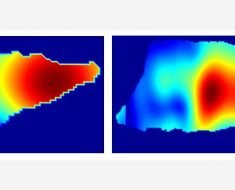Measuring head circumference (also known as occipito-frontal circumference) is a significant part of the proper evaluation of a child’s growth and development, as it represents a direct indication of head growth. Therefore deviations from normal head growth may reveal certain congenital or acquired problem.
In broad terms, microcephaly pertains to an abnormally small head, usually associated with mental deficiency. The incidence is estimated to be 1.6 per 1000 single birth deliveries, although only 14% of all microcephalic infants diagnosed by the first year of age are detected at birth.
Definition and classification
There is no standardized definition of microcephaly, but it is usually defined as an occipito-frontal circumference more than 2 standard deviations (SD) below the mean or smaller with respect to normative growth curves for age, sex and gestation. The condition is also characterized by a reduced (at least 30%) cranio-facial ratio when compared to age-matched normocephalic children.
Nevertheless, this definition is not too helpful for establishing a genetic or syndromic form of microcephaly. In that regard we can distinguish borderline microcephaly at 2 SD below the mean that might be acquired and microcephaly of more than 3 or even 4 SD below the mean, which is far more likely to have a genetic basis.
Several classifications of microcephaly are used in the clinical practice. The most common one is aforementioned division into primary microcephaly that can present at birth (implying genetic influences), opposed to secondary microcephaly which develops later (caused by environmental factors). The condition can also be considered isolated or associated with other congenital anomalies.
Causes of microcephaly
Etiopathogenesis of microcephaly is very heterogeneous, as the condition is believed to stem from decreased neuronal and glial proliferation, as well as increased apoptosis (programmed cell death). Furthermore, there is a separate group of patients born with normal to slightly small head size, but that develop severe microcephaly in the first one to two years after birth.
The genetic causes of microcephaly are due to autosomal dominant, recessive or X-linked gene mutations; rarely mosaicism, balanced translocation or ring chromosomes are found. In addition, more than one hundred well-defined familial syndromes characterized by microcephaly have been documented, with a substantial proportion estimated to be genetic.
Hypoxic-ischemic encephalopathy is considered the main cause of acquired microcephaly. Environmental factors with an impact on developmental processes include prenatal radiation, drugs such as alcohol, as well as various infections (including toxoplasmosis and rubella).
Six months after an epidemic of Zika virus infection started in Brazil in April 2015, a surge in the number of newborns with microcephaly was noted. Although more information is needed to confirm that Zika virus causes this condition, thus far Zika virus RNA was isolated from microcephalic fetuses and amniotic fluid.
Diagnosis and prognosis
The adequate diagnosis of microcephaly and its causes can pose quite a challenge for the physician, as there is a need to pinpoint a correct one amongst an overabundance of pathological conditions. Therefore a multidisciplinary approach that involves the obstetrician, neonatologist, geneticist, neuroradiologist and child neuropsychiatrist is usually warranted.
Practically all forms of microcephaly display a certain degree of simplification of the cortical gyral pattern, with fewer gyri and shallow sulci. Still, such changes of the fetal brain are difficult, if not impossible to assess with prenatal ultrasound.
Thus the sonographic diagnosis is currently based on biometric parameters, with the most important diagnostic criterion being a head circumference below 3 SD from the mean. Other biometric parameters (such as head circumference/abdominal circumference ratio and head circumference/femur length ration) may be useful in doubtful cases.
The prognosis of microcephaly deepens on the etiology, the size of the head and the associated anomalies. When microcephaly is an isolated finding, the mental delay increases with the severity of the impairment of the occipito-frontal circumference; hence the treatment is focused on ways to manage the child’s condition.
Sources
- http://www.ncbi.nlm.nih.gov/pmc/articles/PMC3565221/
- http://onlinelibrary.wiley.com/doi/10.1111/dmcn.12425/pdf
- http://www.virology.ws/2016/02/10/zika-virus-and-microcephaly/
- http://actamedicamediterranea.com/medica/2013/med2013_pag-327-331.pdf
- www.mayoclinic.org/…/con-20034823
- Paladini D, Volpe P. Ultrasound of Congenital Fetal Anomalies: Differential Diagnosis and Prognostic Indicators, Second Edition. CRC Press, Taylor & Francis Group, 2014; pp. 66-68.
- Holden KR, Lyons MJ. Microcephaly – Acquired. In: Maria BL, editor. Current Management in Child Neurology, Fourth Edition. People's Medical Publishing House, Shelton, Connecticut, 2009; pp. 421-428.
Further Reading
- All Microcephaly Content
- Causes of Microcephaly
- Microcephaly Diagnosis: During Pregnancy and After Birth
- Microcephaly Complications
- Microcephaly Epidemiology
Last Updated: Aug 23, 2018

Written by
Dr. Tomislav Meštrović
Dr. Tomislav Meštrović is a medical doctor (MD) with a Ph.D. in biomedical and health sciences, specialist in the field of clinical microbiology, and an Assistant Professor at Croatia's youngest university – University North. In addition to his interest in clinical, research and lecturing activities, his immense passion for medical writing and scientific communication goes back to his student days. He enjoys contributing back to the community. In his spare time, Tomislav is a movie buff and an avid traveler.
Source: Read Full Article





